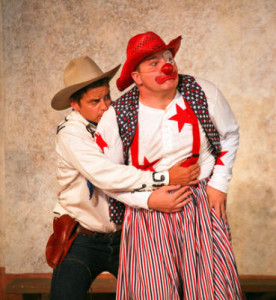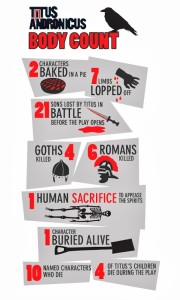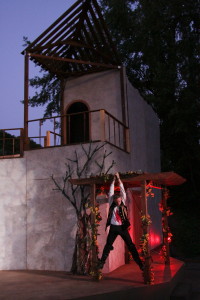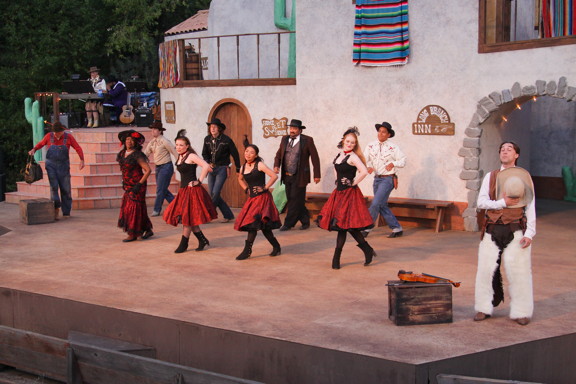Review: A COMEDY OF ERRORS (sic) at Marin Shakespeare Company
September 5, 2013 § Leave a Comment
Not “The,” But Certainly “A,” Comedy of Errors
The Marin Shakespeare Company’s country-western version of Comedy of Errors, adapted and directed by Lesley Schisgall Currier and Robert Currier and set in “old-timey” Texas, is silly and slight, but despite it coming from a very different place than is my usual taste it was nonetheless filled with enough delights to keep me entertained and intrigued.
The Comedy of Errors is an outlier among Shakespeare’s comedies. Although “city” comedies were a popular genre in his time, this is Shakespeare’s one and only play in this less-character-driven style. Errors is an adaptation of a play by the ancient Roman playwright Plautus. It is thought by many – including Marin Shakespeare Company’s Artistic Director Robert Currier – to be his earliest work. The widespread, but imho teleological, argument is that “early” equals “not very good.” The play is often performed, fast and loose, with plenty of buttressing. (In the late ’80s, in a version easily accessible online, The Flying Karamazov Brothers performed it as an extended juggling act.)
While disagreeing that the play lacks substance, even those of us that find hidden depth in the text accede that it is, fundamentally, a farce of mistaken identity. While I missed a serious exploration of family loss and reconciliation (“Ugh,” I can hear the directors say, “go watch Pericles!”), from the perspective of pure performance there is lots to see and discuss.
It Happened Like This…
The plot concerns a scattered family. Long ago, parents Aegeon and Aemilia suffered a shipwreck from which each managed to save an identical twin son and that son’s servant, “coincidentally” also a twin, but were parted from each other. Separately, they each managed to see their charges raised to adulthood, without ever knowing the fates of their lost spouses and children.
Years later, Aegeon (of Syracuse in the play, but Amarillo in this version), is traveling around the Mediterranean (Texas) in search of his long lost wife and her charges, and also his own son and servant who had set out on a similar mission years earlier and never returned. He arrives in Ephesus (Abilene) only to find that the cities are at odds, and he is arrested and sentenced to hang at the end of the day if he cannot find someone who will pay his surety.
Unbeknownst to him, his son and his servant have also arrived in town, but have hidden their origins, and move about unhindered. Unbeknownst to them, both the son’s and servant’s lost identical twins are living and prospering in this city. The “errors” of the play are the constant mistaking of the visiting twin for his resident brother, resulting in the visitor being showered with gifts, praise and even a romantic encounter with his “wife,” (although his heart belongs to the unmarried sister-in-law) while his bewildered brother is systematically denied his money, his home and even his identity. Meanwhile the twin servants are constantly encountering the wrong master. Beatings ensue. In the end, a local abbess manages to sort everything out by finally bringing all the family members on stage at once, and providing a surprise twist of her own. No spoiler: if you don’t know how it ends, go see it!
Twins, Twins
In performance, the most interesting question is how to handle the two sets of identical twins – given that finding even one set of talented twin thespians is not an easy task. Most productions do the next best thing – which is to cast similar looking actors and dress them in nearly identical twin costumes, although usually in some color-coded variation to help us sort them. An interesting variation, perfectly in the spirit of farce, is to cast actors who look absolutely nothing like each other and then dress them alike. I’ve seen a hysterically funny performance in which one of the twin servant Dromios was played by a short, rotund, African-American woman and the other by a tall, thin, almost freakishly white dude. The ease with which we, as audience, could tell them apart rendered even funnier the convention by which the onstage characters could not.
Of course, the premise of the plot requires that the twins are never onstage together until the final scene, so a common solution – and the one adopted by Marin – is to cast just one actor to play the twins using the similar-looking doubles only when it finally becomes necessary.
(Okay, there is one earlier scene in which both Dromios are heard, but one is inside a house of which the other is locked out, so usually only one is visible. By far the funniest sight gag of the evening in Marin was that the interior Dromio – played by the uncredited double – was visible through a window, or would have been had he not been holding an increasingly implausible series of tall props that blocked his face. At first he seemed like an inexperienced actor who didn’t quite realize how large the bottle on the tray he was holding was, but by the time he lugged on a life-sized bust of Shakespeare, the joke was clearly intentional.)

Patrick Russell as Antipholus and Jon Deline as Dromio in Marin Shakespeare Company’s ‘A Comedy of Errors.’ Provided by Eric Chazankin
Star Power
Adopting the single actor solution requires bravura performances. Marin gets them, and then some, from Jon Deline as the Dromios and Patrick Russell as the Antipholi. Literalizing the designation of the Comedians as “Clowns” in Shakespeare’s texts, Deline was costumed (by designer Tammy Berlin) as a rodeo clown with full make-up and fake nose. He is a gifted physical comedian and his best bits were running gags, especially the beatings he took at the hands of his masters. Supplying both grunts and slapping sound effects himself, he managed to alleviate any sense of real harm, while deftly parodying stage combat conventions, by extending the series long beyond the point that his fellow actors mimed contact. The text was so loosely adapted during the entire show, that it made little difference when Deline departed from it, which he did with frequency and relish.
Russell tackled the far more difficult challenge of the Antipholi with astonishing skill. As the visiting Syracuse, he embodied the fresh-faced protagonist perfectly, with growing astonishment as his every wish is granted before it is even spoken, and without any responsibility for his actions. He also captured the loneliness of the character who seemed to be less searching for his missing twin, than trying to find himself. As the smugly privileged brother in Ephesus, his demeanor – not to mention his mounting frustration as his world fell apart – was physicalized so distinctly that it took me a couple of scenes to be certain that the twin performances were being handled by a single actor. When Ephesus finally broke down in what can only be described as a “hissy-fit,” I fell out laughing at his inventiveness.
Bravely, Marin did not color-code the performers in the show. Reappearing in unchanging costumes, they left it to the actors to make clear what is happening. I never had a moment of doubt, however, which Antipholus I was seeing.
Virtuosity
Other kinds of virtuosity were on display in the show, from a cast that doubled as the onstage band, to an extensive display of vocal talent from numerous performers belting out both country-western standards and original songs by Leslie Harlib. Women are generally given short shrift in this play, so Amanda Salazar as Adriana and Elena Wright as Luciana made the most of their opportunities for musical expansion. Shirley Smallwood stopped the show with one great ballad incorporated into her tiny part as the Courtesan. The inserted music was not always well-integrated, and often only a line or two or a famous song was quoted as commentary, but the performances were still impressive. (I’m convinced that the Amarillo was selected as the substitute for Syracuse solely so that Russell could sing “Amarillo by Morning.”) The original songs, however, were more cohesive. Musically they were cw simplistic, but the lyrics were exceptionally clever.
Gary Grossman delivered the most irreverently funny performance of the evening as Dr. Pinch, a crackpot imported to cure the “madness” of Antipholus of Ephesus. Dr. Pinch was portrayed as an Indian Medicine Man, of the most horrendous stereotypical style possible, complete with “How”s and “Ug”s. It might have been unendurably offensive if intended as anything like a real comment on Native Americans, but Grossman performed it all in the broadest Borscht Belt style (and dialect) possible. His chants of “Hey, yu, yu, yu”s had a way of morphing into “Hava Nagila.” In under five minutes he managed to pillory everything from psychoanalysis to the nonsensical premise of the show in the Wild West.
You gotta laugh at a production that can laugh at itself.
Review: THE SPANISH TRAGEDY at the Marin Shakespeare Company
July 25, 2013 § Leave a Comment
A 425 Year-Old Debutante
For fans of Shakespeare and his contemporaries, the warmth of summer brings in the feasting season. Dessert this year is the Marin Shakespeare Company’s production of the rarely performed Thomas Kyd masterpiece, The Spanish Tragedy. (In fact, after 425 years it is said to be making its Northern California debut.)

Hieronimo, Knight-Marshal of Spain (Julian Lopez-Morillas) mourns for his murdered son Horatio (Erik Johnson) in Marin Shakespeare Company’s outdoor production of Thomas Kyd’s “The Spanish Tragedy.”
Photo by Eric Chazankin
The plot of Kyd’s revenge tragedy has more than a passing resemblance to Hamlet, a comparison from which it usually suffers but which also supplies it endless fascination. Although its date of composition is uncertain most scholars place it in the mid-to-late 1580s at just about the same time Shakespeare was probably starting his career in London. It is some dozen years older than Shakespeare’s Hamlet, a model therefore, and not a copy.
Spanish Tragedy opens with a ghost seeking revenge – accompanied in the play by a character named Revenge, in fact. It also features a doubting and delaying revenger who feigns madness to buy time, a woman driven genuinely mad by loss who eventually commits suicide, and a decisive play-within-a-play. Solely on the evidence of this resemblance, in fact, Kyd is believed to be the author of the mysterious ur-Hamlet, the now lost play on which Shakespeare is thought to have based his version.
The misfortune of the Spanish Tragedy is that through most of the twentieth century it was usually studied not because it is the progenitor of the revenge tragedies that dominated the Elizabethan stage, although it is, but as a less subtle comparator to Hamlet, useful for teleological arguments “proving” Shakespeare’s genius. Theater companies have had little incentive to produce it because the inevitable criticism is that it is nothing but a sensational oddity from the dustbins of history.
Body Counts and Comparisons
Among the things that becomes clear from watching the play in performance in Marin (from an edition prepared by the company’s skillful dramaturg, Mary Ann Koory) is that Hamlet is the wrong comparator. It is far more like Shakespeare’s first – and decidedly unsubtle – revenge tragedy, Titus Andronicus. It has a plotting Iago-ish Machiavellian character at its center, like Titus’ Aaron. The revenger is not a son, but a father, like Titus. A powerful woman drives the plot forward, like Tamora. Most of all, it is not structured around introspective monologues, but (exactly like Titus) around grisly and horrific violence – lots and lots of violence. If you are not familiar with Titus, the Royal Shakespeare Company has prepared a helpful graphic of the body count for its current production, attached here.

The Royal Shakespeare’s infographic of the Titus body count, to which Spanish Tragedy is a worthy rival.
Similarly, The Spanish Tragedy begins with a murdered minor nobleman, Don Andrea, tallying the deaths from a war in which, by the rules of chivalry, he would have been taken prisoner for ransom instead of killed. It proceeds through the onstage murder of a bound victim, two ambushes of unsuspecting co-conspirators to eliminate witnesses, a narrowly averted burning at the stake of an innocent man, an unexpected hanging of a guilty one who thought he had bribed his way to freedom, an offstage suicide, a final scene with so many deaths that it leaves the lines of succession of both Spain and Portugal destroyed, and the hero biting out his own tongue so he cannot be forced to confess!
Before “To be, or not to be” there was “Oh eyes, no eyes”
Titus, of course, was not held in high esteem until very recently, when it began to be judged by its own Senecan aesthetic aims instead of belittled for not being more like the late tragedies. Ironically, it was Shakespeare’s most successful play in his lifetime. It did not hold a candle to Spanish Tragedy, however, which was the most successful play of the entire period. It has more recorded performances and more references in plays, poems, and diaries than any play before the Commonwealth. What “To be or not to be” is to us now, the protagonist, Hieronimo’s, great speech “Oh eyes, no eyes, but fountains fraught with tears” was to the early modern audience then.
Julian Lopez-Morillas plays Hieronimo with a riveting intensity throughout, but his delivery of the famous monologue confirmed its still current fascination, as he used it to shift the action into a higher gear. His dark humor and grisly determination had the same kind of power that Antony Hopkins brought to Julia Taymor’s filmed Titus. In his hands we begin to see what all the fuss was about.
Few in the cast could keep pace with him, but Elena Wright was an intriguing (in both senses of the word) Bellimperia, the female lead around whom much of the plot turns. Female characters from the period generally do not have the agency and intensity that Bellimperia has, and Wright reveled in the chance to play her strength. Erik Johnson was a very charismatic Horatio, the young man in love with her, and the presumed revenger, until he is captured and casually murdered in front of her (and us) midway through the play. Scott Coopwood played Bellimperia’s father, a particularly complex role, notably.
It is carping to note that much of the rest of the very large cast was less experienced, since the economic reality is that is about the only way any company could afford to mount this show. The divide between the professionals and the others was wide, however, and both the pace and the verse speaking suffered often because of it. The production’s strengths were heavily invested in the protagonists, unbalancing the action when the antagonists were (at least theatrically) not their match. A surprising set of comic characters who seem to have wandered into the tragedy from Much Ado, however, helped to energize the second half.
Beautiful Executions
Set Designer Shannon Walsh created a beautiful and varied Spanish compound, but for some reason chose not to structure any visual relationship between the three sets of gallows for major executions that sub-divide the play into acts – often thought of as the main visual motif of the play. Costume Designer Abra Berman gave us authentic period appearances for the characters, especially effective in visually aiding the audience to keep track of the complex alliances and shifting locales.

The murder of Hieronomo’s only son, Horatio (played by Erik Johnson, pictured), sets off a chain of murderous events in Marin Shakespeare Company’s outdoor production of “The Spanish Tragedy.”
Photo by Eric Chazankin
“Where Words Prevail Not, Violence Prevails”
Only in the final moments of the play did the production completely rise to the occasion, bring home to message encapsulated by its most famous line. When it blossomed into its full potential, however, it was easy to see why the vicarious power fantasy of revenge, and the sensational violence, was as popular as it was. In much the way that Titus has been rehabilitated in the last half century after nearly three hundred years of dormancy, The Spanish Tragedy seems ripe for rediscovery. The combination of black humor and suppressed rage at state sponsored (or at least tolerated) injustice – of which poor Kyd as a victim when he was tortured and his health permanently destroyed as collateral damage in the campaign to ensnare Christopher Marlowe – was not a Victorian taste, but seems all too apropos these days. We can only thank and admire Marin Shakespeare Company for exploring this gem.

